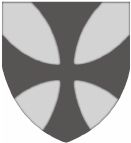Copyright 2017 Helena P. Schrader. All rights reserved. No part of this book may be reproduced or retransmitted in any form or by any means without the written permission of the publisher.
Historical figures are in bold; characters who appear twice are marked by an *; dates in italics are estimates.
House of Jerusalem
Isabella, Queen of Jerusalem, b. 1172, reigned 1190-1205
Henri de Champagne, consort of Isabella 1192-1197
Marie de Montferrat, daughter of Isabella by her second husband, Conrad de Montferrat, b. 1192, reigned 12051211
Marguerite, daughter of Isabella and Champagne, b. 1194, died before 1205
Alice, daughter of Isabella and Champagne, b. 1195, m. King Hugh I of Cyprus 1210, died 1246
Philippa, daughter of Isabella and Champagne, b. 1196
House of Lusignan
Guy de Lusignan, King of Jerusalem 11861190, widower of Queen Sibylla
Aimery de Lusignan, his elder brother, King of Cyprus, 11961205, King of Jerusalem 11971205
Eschiva dIbelin,b. 1165, Aimerys first wife from ca. 1173
Guy, their eldest son, b. 1182, died before 1205
Burgundia, their eldest daughter, b. 1184
Helvis, their second daughter, b. 1186
John (called Aimery to avoid confusion with John dIbelin), their second son, b. 1189, died before 1205
Hugh, youngest son of Aimery and Eschiva, b. 1195, King of Cyprus 12051218
House of Ibelin
Balian dIbelin, b. 1149, Baron of Ibelin 11771187, Baron of Caymont 11921199
Maria Comnena, his wife, b.1154, Queen of Jerusalem 11671174, mother of Queen Isabella,* d. 1217
Helvis, their eldest daughter, b. 1178, m. Reginald de Sidon ca 1192
John, their eldest son, b. 1179, Constable of Jerusalem 1198, Lord of Beirut from 1202, d. 1236
Margaret, Balian and Marias second daughter, b. 1181
Philip, Balian and Marias second son, b. 1182
Eschiva*, Balians niece
Henri de Brie, Balians nephew, son of his half-sister Ermengard, b. 1166
Heloise, his wife
Anseau, their eldest son, b. 1184 (Note: Although we know Anseau de Brie was a grandson of Balians half-sistereither Ermengard or Stephaniewe do not know his fathers name. His grandfather was Anseau.)
Conan, their second son, b. 1185
Other Barons of Outremer
Richard of Camville, appointed baillie of Cyprus by Richard I
His son Richard, Dick, squire to Guy de Lusignan
Robert of Thornham, appointed baillie of Cyprus by Richard I
Humphrey de Toron, formerly a baron in the Kingdom of Jerusalem, first husband of Isabella of Jerusalem (the marriage was annulled by a Church court headed by the Papal Legate in November 1190)
Galganus de Chenech, adherent of King Guy at the latest from the siege of Acre 1189 onwards
His son, Gauvain
Reynald Barlais, a Poitevin supporter of the Lusignans
Aimery de Rivet, seneschal of Cyprus in 1197
Walter de Bethsan
Ibelin Household
Georgios, Balians squire
Beatrice dAuber, Marias widowed waiting woman, a former Saracen captive
Bart, Amalric, and Joscelyn, her sons
Anne, Beatrices niece, lady to Eschiva de Lusignan
Sir Galvin, a Scottish knight
Sir Sebastian, a Syrian Christian knight
Sir Constantine, an Edessan knight with Armenian blood
Father Angelus, Maria Zos confessor, tutor to the children
Greeks
Abbot Eustathios, Abbot of Antiphonitis
Brother Zotikos, a monk of Antiphonitis
Lakis, an orphan whose parents were murdered by the Franks
Andreas Katzouroubis, an apothecary
Father Andronikos, a priest
Captain Kanakes, a pirate
Italians
Carlo di Rossi, a caravansary/khan owner
Mario, his brother
Francesco Pasquali, bailli of the Pisan commune on Cyprus
Armenians
Leo, Prince (later King) of Armenia
Simon, Lord of Corycos
Ravon, his son



IN CONTRAST TO MY JERUSALEM TRILOGY, the historical basis for this novel is very thin. The early history of the Kingdom of Cyprus is largely lost in the mists of time, and much of what we think we knowor what is currently accepted in academic circlesis dubious. There are grounds for questioning some of the common assumptionssuch as the year of Balian dIbelins death, the uncompromising nature of Ibelin hostility to Aimery de Lusignan, the late arrival of the Ibelins on Cyprus, and more. I hope to publish a history of the Ibelins, in which I will raise a number of these issues in a nonfictional format in order to invite scholarly discussion.
Meanwhile, however, this novel offers a fictional depiction of events as I believe they could have happened, including the usual advantages historical fiction offers with respect to exploring human nature and relationships. As a novel, this book looks at the founding of the Kingdom of Cyprus in the years 1193-1198but also at the ever-recurring need to pacify countries or regions that have been torn apart by wars, invasions, and tyrannical government. This is a novel of medieval Cyprusand of post-conflict reconstruction around the world in any age.
But first a few words about the period and characters in this novel, and about the major revisionist thesis incorporated in the novel and why.
We know that Richard I of England, having conquered Cyprus in May 1191, sold it to the Knights Templar for one hundred thousand bezants in July of the same year. According to Peter Edbury, the leading modern historian of medieval Cyprus, Templar rule was rapacious and unpopular, resulting in a revolt in April 1192. Although a Templar sortie temporarily scattered the rebels, the causes of the revolt were hardly addressed, and the latent threat of continued and renewed violence was clear. In the circumstances, the Grand Master of the Templars recognized that his Order would have to invest considerable manpower to regain control of the island. He also recognized that he did not have the resources to fight in


















